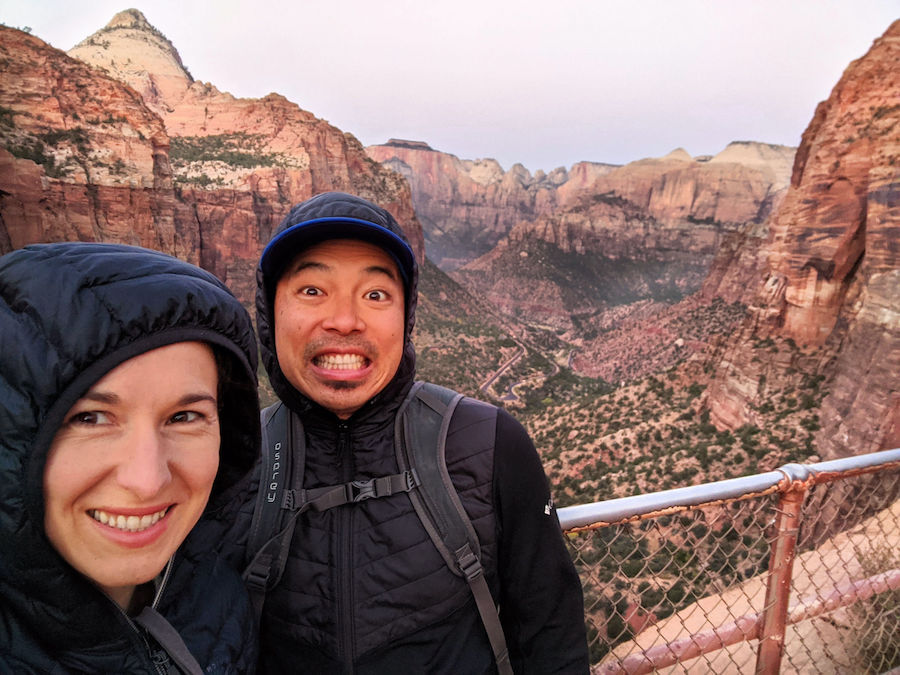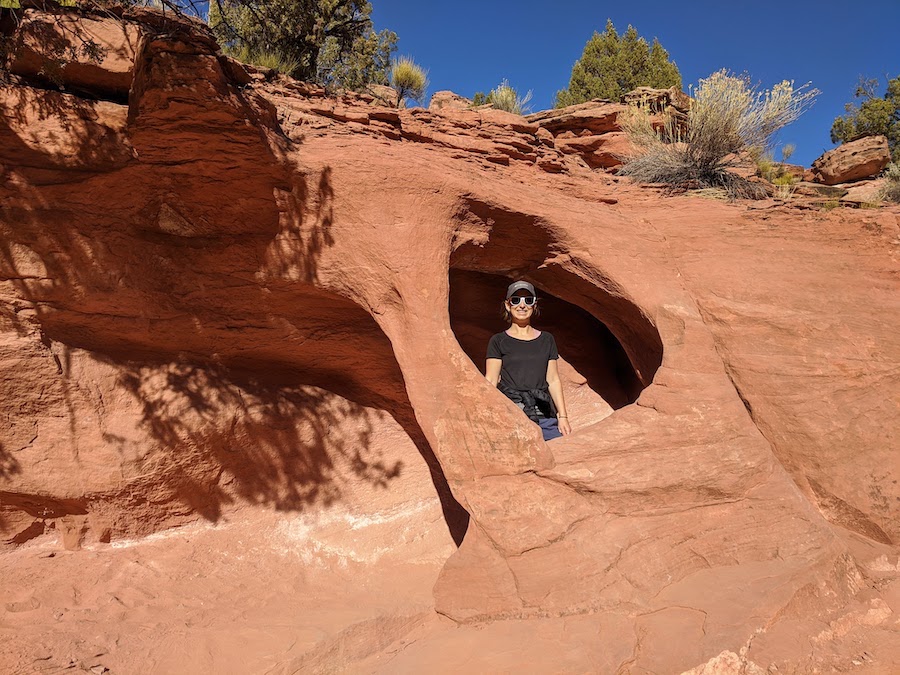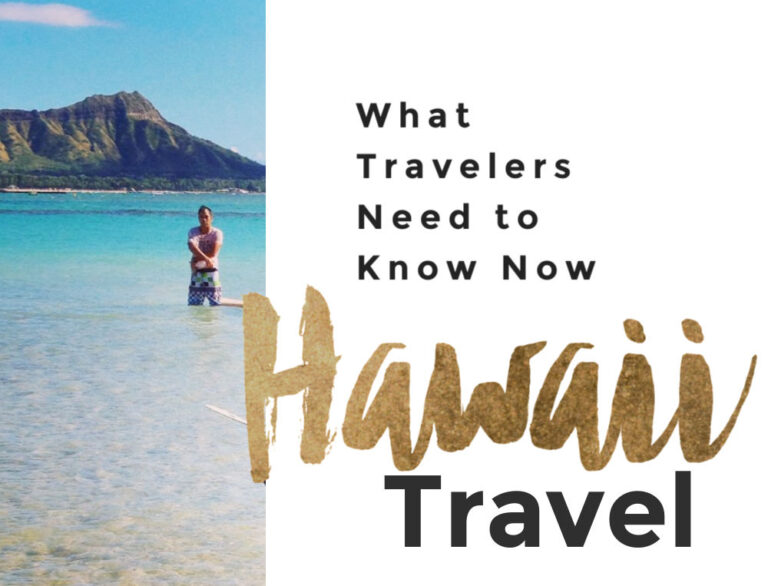Driving Utah National Parks: 7 Day Road Trip (Map + Itinerary)
Use our Utah National Parks road trip map and itinerary to plan the perfect one week driving tour through some of America’s best National Parks of the West.
Our 2 Utah National Parks road trips
Our first trip to Utah National Parks was during a one-month National Parks camping road trip in 2011, before starting our Peace Corps service.
We loved it!
Utah’s beauty is so different from where we grew up (Oregon and Hawaii). But I think that’s what makes Utah’s Parks especially captivating: they feel like they’re not of this world!
Reds and oranges. Textures like thousand-layer pancakes cut through with a sharp knife, or blobs of wet sand plopped in columns as big as buildings.
From an aerial view, this part of Utah may look dry and bland. But up close, every corner has new shapes and shades of the rainbow.
In 2020, we revisited the Utah National Parks in October on a 7 day road trip. This time we stayed in Airbnbs, while practicing responsible, social distance travel.
Disclosure: This post contains affiliate links. That means if you make a purchase through one of our links, we may receive a small commission, at no additional cost to you.
Table of Contents
Utah National Parks Road Trip Map + PDF
Best Utah Road Trip Itinerary
The ideal Utah National Parks tour includes:
– Arches National Park
– Canyonlands N.P.
– Bryce Canyon N.P.
– Zion N.P.
– Capitol Reef N.P.
– Grand Staircase-Escalante National Monument
That is a lot to cover in a 7 day Utah Parks itinerary! But yes, it can be done.
When limited to one week, most travelers skip Grand Staircase, as many of its attractions are more remote.
Capitol Reef and Canyonlands are not as well known and many skip these as well.
That being said, if you wish to avoid crowds in the Utah National Parks, you may want to spend more time at Grand Staircase-Escalante, Capitol Reef, and Canyonlands.
Let’s take a look at each of these Utah National Parks one by one, then we’ll answer some Frequently Asked Questions about Utah Parks road trips.
Bryce Canyon National Park
Bryce Canyon National Park is most famous for having the greatest concentration of hoodoos on Earth. Hoodoos are irregularly eroded columns of rock. It’s a beautiful geological wonder to behold!
Bryce is one of my all-time favorite National Parks and definitely deserves a top spot on your Utah National Parks itinerary. That being said, you can easily see the best of Bryce Canyon within half a day if needed.
Check the Bryce Canyon National Park website for visitor information
Bryce Highlights:
– Hiking among the hoodoos
– Sunset and Sunrise viewpoints
– Ranger talks and astronomy programs
– Canyon horseback rides
Best Hikes in Bryce:
– Queen’s Garden and Navajo trails (2.9 mile loop, moderate difficulty): A must see! Bryce’s most popular hiking trail packs a punch, with gorgeous vistas and fascinating geological formations.
– Peekaboo Loop (5.5 miles, strenuous): Combine this in a figure-8 with the Queen’s/Navajo loop above for a spectacular half-day work out.
– Rim Trail: For folks with less mobility, or short on time, walk from the parking lot on this wide, paved path above the canyon. View Sunrise and Sunset points, about 1 mile apart.
Recommended Accommodations for Bryce Canyon:
Comfortable cabin on a one-acre property. Perfect for families. Just one mile from the Bryce Canyon park entrance and walking distance to restaurants.
TIP: 🛏️ When it comes to accommodations, finding the right balance between cost, location, and comfort is worth getting right. But it doesn’t have to take hours of online searching!
I’ll teach you how to pinpoint your own perfect accommodations efficiently and avoid disappointing stays in my Smart Stay Finder course.
Bryce Activities:
Zion National Park
Zion is Utah’s first and probably most popular (read: crowded) National Park.
On our Utah National Parks road trip map, you’ll see Zion is in the southwest corner of the State. This makes Zion National Park an ideal place to start a trip, especially if you’re coming from Las Vegas or California.
Zion’s main canyon boasts colorful, epic scenery and wildlife. But you can also visit a separate corner of the park, Kolob Canyon, that’s much less crowded.
Check the Zion National Park website for visitor information
Zion Highlights:
– Hiking in Zion Canyon or Kolob Canyon
– Driving through the mile-long Mt. Carmel tunnel
– Cycling the Zion Canyon Scenic Drive
Best Hikes in Zion:
– West Rim Trail to Angel’s Landing (5.4 miles, strenuous): Switch back climb with epic views. For those with fear of heights, skipping the final section to Angel’s Landing is still a great hike.
– The Narrows (up to 9.4 miles): A trek through the river itself, inside a narrow gorge with walls a thousand feet high.
Recommended Accommodations for Zion National Park:
A family-run oasis next door to Zion N.P. and walking distance to restaurants in Springdale.
Check rates, photos, & availability for Nama-Stay Suites >
Zion Activities:
Capitol Reef National Park
Capitol Reef is the most underrated Utah National Parks trip destination, in my opinion.
It’s also centrally located between the Western Utah parks (Bryce and Zion) and the Eastern parks (Arches and Canyonlands). Plus it’s next door to Grand Staircase-Escalante. With this location, Capitol Reef can make a great home base for a Utah National Parks vacation.
After a too-brief visit on our first trip, I made sure to spend extra time at Capitol Reef the second time around.
With such striking, unusual landscapes and relatively few crowds, Capitol Reef National Park is a hiker’s paradise.
Check the Capitol Reef National Park website for visitor information
Capitol Reef Highlights:
– Hiking through unusual geologic formations
– Scenic drive into Grand Wash and Capitol Gorge
– Petroglyphs and pictographs by Fremont peoples
– Historic pioneer farmstead in Fruita
Best Hikes in Capitol Reef:
– Grand Wash (up to 4 miles, flat): A dry streambed trail through the narrows of a sculpted canyon with fascinating rock colors and textures. Option to add on a climb to Cassidy Arch.
– Hickman Bridge (1.8 miles, moderate): Canyon views and a grand rock arch/bridge.
Recommended Accommodations for Capitol Reef:
Cute, top rated cabin on an acre, a short drive from the park. Kitchenette and incredible views.
Check rates, photos, & availability for Tiny House in Torrey >
Budget Alternatives: Capitol Reef campgrounds ($), Wonderland Cabins ($/$$)
Luxury Alternative: Cougar Ridge Lodge villas ($$$)
Grand Staircase-Escalante National Monument
Grand Staircase-Escalante is actually a National Monument, which covers almost a million acres. Full of cliffs, slot canyons, river gorges, rock arches, fossils, and native artifacts, these public lands rival the other National Parks in Utah.
Unfortunately, these attractions are extremely spread out and not as accessible.
For convenience on a Utah road trip, we recommend visiting the area around Escalante, UT. This includes part of the Scenic Byway 12.
Check the Park website for visitor information
Grand Staircase Highlights:
– Scenic Byway 12 viewpoints and overlooks
– Hiking diverse terrains
Best Hikes in Escalante:
– Lower Calf Creek Falls (6 miles, moderate): The stunning waterfall at the end is matched by fascinating terrain along this relatively flat but sandy out-and-back trail – pictured above.
– Coyote Gulch (11.5 miles, strenuous): A semi-narrow canyon that snakes its way through incredible red rock landscapes and arches.
Recommended Accommodations:
Top-rated, refurbished barn-turned-cabin in Escalante town. A unique, comfortable, and convenient stay.
Budget Alternative: Calf Creek Campground ($)
Luxury Alternative: 40 Acre Retreat ($$/$$$), Escalante Yurts ($$$)
Escalante Activities:
Canyonlands National Park
Adding Canyonlands to your Utah National Parks driving tour may depend on how much time you have. With its primitive desert landscape, it’s not quite as flashy as Arches, Zion, or Bryce, so some visitors choose to skip it.
That being said, Canyonlands National Park is a short drive from Arches, so it’s easy to make a day trip out of it.
Check the Canyonlands Park website for visitor information
Canyonlands Highlights:
– Horseshoe Canyon’s “Great Gallery” has some of the most significant rock art in North America
– Impressive canyon vistas along the Island in the Sky Scenic Drive
Best Hikes in Canyonlands:
– Mesa Arch (0.5 miles, easy): A short loop trail to Canyonland’s most iconic rock arch.
– Grand View Point (2 miles, easy): Great for panoramic views of Candlestick Tower, the Green River, and the White Rim Road.
Recommended Accommodations:
See Arches accommodations below for more options outside the park.
Canyonlands Activities:
Arches National Park
No Utah National Parks road trip itinerary is complete without a stop in Arches. True to its name, this open desert landscape is home to thousands of red rock archways and other fun stone formations.
Arches National Park is located just outside of Moab, Utah, an outdoor adventure hot spot of its own. This is the closest park to Utah’s Eastern border with Colorado.
Check the Park website for visitor information
Arches Highlights:
– Taking a scenic drive to countless viewpoints
– Hiking among the arches
– Rock climbing, canyoneering, biking, or horse-back riding
Best Hikes in Arches:
– The Windows (1 mile, easy): An easy climb to view massive rock windows and Turret Arch.
– Delicate Arch (3 miles, moderate): A steady uphill, passing a wall of Ute Indian petroglyphs, to get up close to one of the most iconic arches.
Recommended Accommodations:
This fully-equipped, private cottage in Moab has great livingroom views and a hot tub.
Check rates, photos, & availability for Quiet Guesthouse >
Budget Alternative: Edge of the Desert tiny houses, Devil’s Garden Campground
Luxury Alternative: Modern Moab Villa (for 8); Exclusive Retreats 3bdr Home
Arches Activities:
 * Get our Utah National Parks map & itinerary PDF pack *
* Get our Utah National Parks map & itinerary PDF pack *
Utah National Park Road Trip Itinerary Tips
How many days do you need to visit Utah Parks?
Technically, you could see the Utah Big 5 in a five day road trip. Driving distance is short enough, but this would allow very little time to actually enjoy yourself.
We recommend at least a one week Utah road trip itinerary. Two weeks in Utah National Parks would be even more ideal to get off the beaten path and explore the best of all the parks.
Best Time to Visit Utah Parks
Generally, the best time to visit US National Parks is in “shoulder season” when the weather is still nice but there are fewer crowds. That means avoiding school breaks, hot summers, and freezing winters.
Typically, Fall is a great time to take a southwest National Park road trip through Utah.
Which is better: Bryce or Arches? Zion or Moab?
You’ll see on our Utah National Parks map that Bryce and Zion are closest to each other on the West side of Utah. Arches and Canyonlands are on the East near Moab, Utah.
The best Utah parks to visit is personal preference. They are each so unique, it’s difficult to compare.
If you’re short on time and can’t see all the parks, I would pick whichever are closest to you geographically, to maximize your time in the parks. Whichever you choose will make for an amazing trip!
What should you pack for a road trip in Utah? What should I wear?
If you’ll be camping, see our epic camping road trip packing list. Don’t forget good hiking shoes and light-weight, layered clothes for the outdoors. It does get hot in the summer but can cool off at night, so a light jacket is recommended.
In winter, bring a heavier jacket, hat, gloves, and moisture-wicking layers. Sunscreen and water bottle are also must haves.
Alos, don’t forget your National Parks Pass!
Do you need bug spray for mosquitos in Utah?
Fortunately, Utah’s dry climate means there are not many mosquitos around the National Parks. Mosquitos may be more common around Salt Lake City at some times of the year, but it’s not usually a significant concern Utah National Parks.
We hope this Utah National Parks trip planner has been helpful. Let us know in the comments if you have your own recommendations to add. And don’t forget to get your National Parks in Utah map and road trip itinerary PDF pack here.
Like this post? Pin it for later or share with friends!
























hello. we are planning a road trip in May with our well-trained pup. I checked out several of the lodging sites posted on your site and they all seem to be non dog-friendly. LaQuinta Moab and also in LaVerkin are pet friendly. Any suggestions for us?
Also we are driving from the Olympic Peninsula in WA so would beginning in SLC be the best route?
Thank you!
We are coming to Utah in November around the 6 to the 12.
We are bringing my 11 year old granddaughter.
Any suggestions for activities.
We hike but don’t want difficult hikes.
Are the activities still available I. November
Hi Ellen. There are plenty of easy hikes throughout the Utah Parks. If you’re not able to find the info you’re looking for in our post, each Park has up to date recommendations and calendars in a brochure that you can pick up at the entry or visitor center.
Thanks for the info. As seniors we need to see as much as we can without hiking. Which parks have the best scenic drives? Know we’ll miss a lot without hiking, but we are not physically able.
Thanks for visiting our blog! Several of the parks have well known scenic drives, which we’ve mentioned in this post. Capitol Reef and Arches come to mind as the best parks to view from your own car. Zion’s valley is not self-drive but you can take the park shuttle to experience that scenic drive.
Thanks for the information it is great. Which hikes would you recommend for beauty but avoiding dangerous hiking since my family are newbies and are afraid of heights in tight quarters. Also I’m thinking of let’s say doing 5 days or less, which would you avoid or if easier the must do’s.
Hi Fred. Great question. Most of the Parks have so many hikes, you’ll be able to find beginner-friendly non-scary hikes to suit your preferences. It might be easiest to start with Bryce and Zion, as both have great viewpoints without necessarily needing to hike up or down and your driving time will be minimal. You could add Arches as well for scenic drives and light hiking to see some of the best sights. Hope that helps!